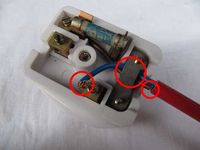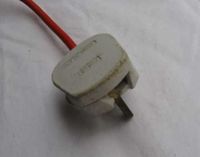PAT testing
This is a basic "survival guide" to PT testing.
N.B. This guide has not yet been validated by a qualified PAT Test Technician and so should only be used for general guidance until such time as it is.
Summary
Portable Appliance Testing (PAT) is used to identify electrical faults in mains appliances which can make the appliance unsafe to connect to the mains or use. In the context of a Restart event, mains operated appliances must be both before and after any attempted repair.
A PAT test comprises two parts:
- A Visual Inspection. This is the most important part and must be done first, and it reveals the majority of faults.
- As part of this, you must identify the Class of the appliance, which is a prerequisite to performing the second part.
- An Automated Test using a PAT tester. This should not be performed until any faults identified in the visual inspection are fixed.
It's essential to understand that the automated test requires that you correctly identified the class of equipment, since if you get this wrong you could pass a faulty appliance with potentially dangerous consequences.
- A test is required before any repair, so that the owner and repairer know the initial condition. This might reveal the item is not be safe to plug in, presenting a danger to owner, repairer, and others at the event. Such faults could also cause the electricity supply at the event to be tripped off, inconveniencing others, particularly if there is no access to get the power switched back on. The repairer should fix the fault causing the the PAT failure before attempting to fix any other fault in the appliance.
- A test is also require after any repair or opening up of the appliance. This is to ensure the appliance is safe to use afterwards, and that the repair has not caused a fault. If an appliance if not safe to use (e.g. the PAT fault was not repaired), the owner should not take it away in a usable state--the mains plug should be removed or at a minimum the fuse removed, so the owner cannot connect the appliance to the mains.
Visual Inspection
Statistics show that 90% of faults are detected by visual inspections, which can reveal faults that an automated electrical test may not. A visual inspection should therefore should never be skipped.
You should perform the following checks:
- Check for fraying of the mains lead, or cracking of the insulation, or any such deterioration which has simply been taped over. In the event of any cracking of the inner insulation exposing the copper conductors, the owner should be advised that the appliance is positively dangerous, and must not be used until the mains lead has been replaced as it is likely to constitute a fire or electric shock hazard.
- Check for a cracked or broken plug, or any signs of overheating. This will need to be replaced before the appliance can be declared safe.
- Check that the cable clamp on the plug (and on the appliance itself, if there is one) is firmly gripping the cable and allowing no movement. Often, this can be rectified by refitting the plug.
- Open the plug and check that it's correctly wired, the screw terminals are tight, and that a suitable fuse is fitted. Even if you don't open the plug, check the screws are tight. (In the case of a moulded-on plug there will be no screws and you won't be able to open it.)
Appliance Classes
Before you can perform the Automated Tests, it's necessary to understand the different Classes of appliance, otherwise these tests cannot be performed reliably. But as you'll see, you only need to worry about Class 1 and Class 2.
Class 1
The mains lead of a Class 1 appliance has 3 wires. In addition to the Live and Neutral (which carry the electric current to the appliance, and return it to the mains outlet), there is an Earth wire, connected to the metal frame. In the event of a fault, this provides a much easier return path for the current than through your body, so greatly reducing the risk of electric shock.
- The Live is brown. (That's the colour your trousers go if you touch it!)
- The Neutral is blue - a pretty neutral and benign colour.
- The Earth is green, with a yellow stripe. (Green for earth should be easy for earthlings to remember.)
Note that a Class 1 appliance may or may not have any exposed metal parts, but internally will normally have a metal frame.
Class 1 is divided into:
Class 1 Metal
This has exposed metal parts which are connected to the earth wire.
Class 1 Plastic
Internal metal parts such as a frame or a motor casing are connected to earth, but the outer casing is plastic (although it might have some isolated metalwork on it such as a rating plate or decorations).
Class 2
Class 2 appliances just have 2 wires. (That's pretty easy to remember, isn't it?) These are the Live and Neutral. Class 2 appliances have no exposed metal parts which could possibly become live and create an electric shock hazard in the event of a fault. Nevertheless, they may still have exposed metal parts which are doubly insulated from the mains supply.
Class 3
Class 3 appliances are extra low voltage devices running off batteries or a separate mains adapter (which itself might be Class 1 or Class 2). Since extra low voltages don't constitute an electric shock hazard, no testing is required.
Class Identification Summary
To determine whether an appliance is Class 1 or Class 2, run down the following checklist until you have the answer.
- Does the appliance have a double-square "Double-Insulated" sign? If so, it's Class 2.
- If it has a detachable mains lead, how many holes does the appliance end of the lead have (or how many pins does the socket on the appliance have)? If 2, it's Class 2, or if 3, it's Class 1.
- Is the earth pin of the plug made of plastic, not metal? If so, it's Class 2. (The earth pin is the one which is bigger than the other two.)
- Remove the lid from the mains plug if you can. How many wires are there connected in the plug? If only 2 (brown and blue) then it's Class 2, but if 3 (brown, blue and green/yellow) then it's Class 1.
- If you can remove the cover from the appliance, try and see how many wires emerge into it from the mains lead. If only 2, it's Class 2, but if 3, then it's Class 1.
- Does the mains lead have an obviously oval shape, indicating just 2 wires inside, side by side? If so, it's probably Class 2. (But a round mains lead may equally be Class 1 or Class 2.)
- Does the appliance have a metal case? Then it's probably Class 1, unless it's audio/visual equipment which may be Class 1 or Class 2.
- Does the appliance have a case made entirely of plastic, with no exposed metal parts? Then it's probably Class 2. (Note that the element of a kettle counts as "exposed" as you could get your hand in there and you could certainly touch the water. But you couldn't get your hand inside a hair drier to touch the element.)
Automated Tests
The Restart Project has a BattPAT automatic PAT tester. Here is the manual and a video showing how to use it. This is summarised below. The same instructions should be broadly applicable to other models of PAT tester.
Class 1 Metal Test
- Plug the appliance into the PAT tester.
- Clip the earth lead onto a metal part of the appliance.
- Switch the appliance on.
- Press the Class 1 Metal button.
- Check that no Fail indicators light up.
Class 1 Plastic Test
- Plug the appliance into the PAT tester.
- Leave the earth lead to one side.
- Switch the appliance on.
- Press the Class 1 Plastic button.
- Check that no Fail indicators light up.
Class 2 Test
- Plug the appliance into the PAT tester.
- If the appliance has any exposed metal parts, clip the earth lead onto one of them.
- Switch the appliance on.
- Press the Class 2 button.
- Check that no Fail indicators light up.
Important Note
Never try to determine what Class an appliance is by seeing which test passes. If a test fails and you're not certain that you've selected the right Class, always ask someone more experienced for assistance.
Detachable IEC Mains Lead Test
- Plug both ends of the mains lead into the PAT tester. (In the case of a clover-leaf lead, you will need an adapter which should come with the tester.)
- Press the Power Cord button.
- Check that no Fail indicators light up.
Mains Extension Lead Test
- Plug the mains extension lead into the tester.
- Plug an IEC lead which came with the tester, or a known good one, into the mains extension lead.
- Plug the other end of the IEC lead into the tester.
- If the extension lead is over 10m in length, press the Long Lead button.
- Press the Power Cord button.
- Check that no Fail indicators light up.
- If the extension lead has more than one socket, repeat with each of the remaining sockets in turn.
Safety
As previously stated, it is essential to correctly identify the class of an appliance otherwise a faulty appliance could be passed as OK with potentially dangerous consequences.
Do not touch metal parts of an appliance during testing. Though unlikely, it is theoretically possible that you could get an electric shock if the appliance is faulty or the earth lead is not attached securely.
All mains powered appliances should be PAT tested both before and after a repair is attempted.
A faulty appliance must have its mains plug removed and the owner must be informed that it is unsafe unless the fault can be immediately rectified (e.g. by replacing a cracked mains plug).
References
External links
- External links as bullet points

